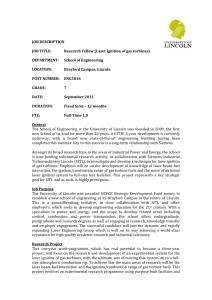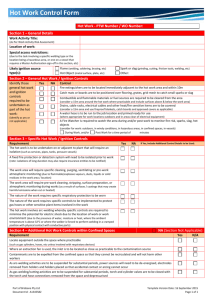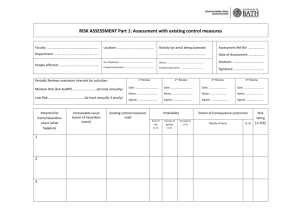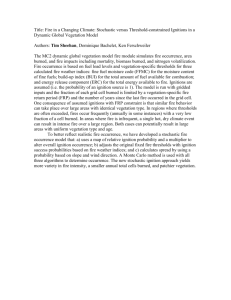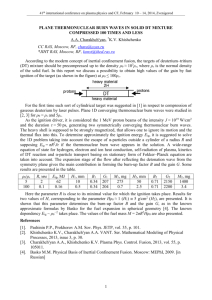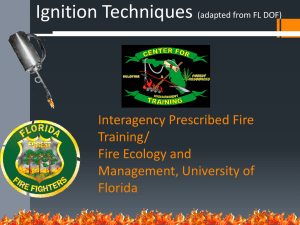OSFM Structure Protection Checklist Instructions Home Ignition
advertisement
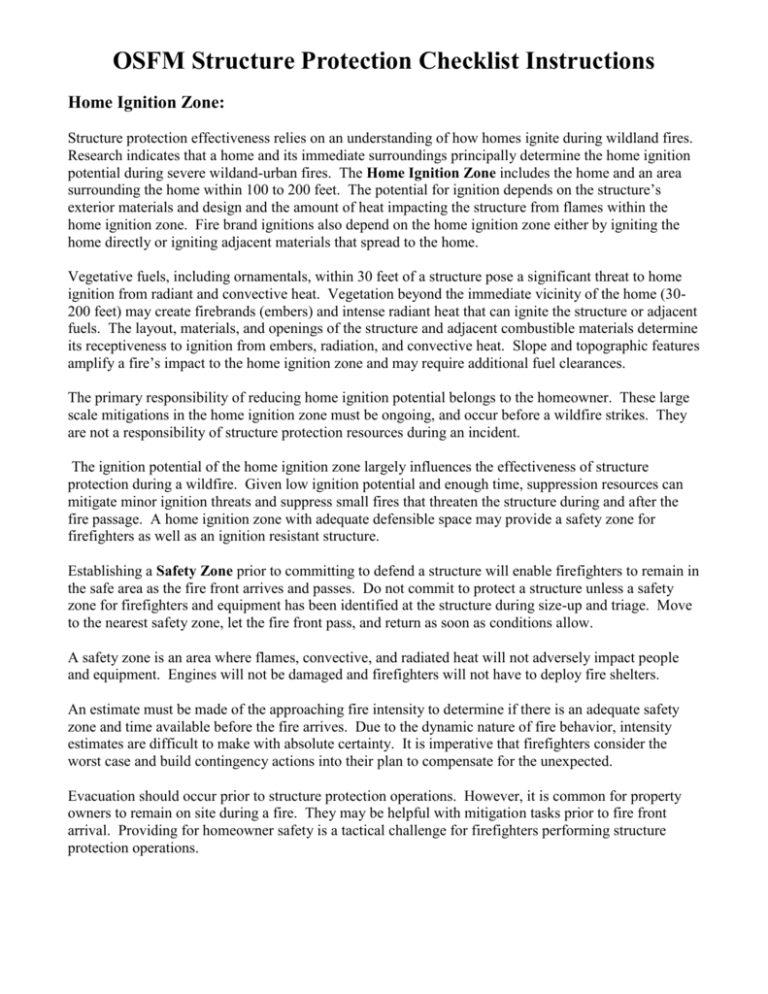
OSFM Structure Protection Checklist Instructions Home Ignition Zone: Structure protection effectiveness relies on an understanding of how homes ignite during wildland fires. Research indicates that a home and its immediate surroundings principally determine the home ignition potential during severe wildand-urban fires. The Home Ignition Zone includes the home and an area surrounding the home within 100 to 200 feet. The potential for ignition depends on the structure’s exterior materials and design and the amount of heat impacting the structure from flames within the home ignition zone. Fire brand ignitions also depend on the home ignition zone either by igniting the home directly or igniting adjacent materials that spread to the home. Vegetative fuels, including ornamentals, within 30 feet of a structure pose a significant threat to home ignition from radiant and convective heat. Vegetation beyond the immediate vicinity of the home (30200 feet) may create firebrands (embers) and intense radiant heat that can ignite the structure or adjacent fuels. The layout, materials, and openings of the structure and adjacent combustible materials determine its receptiveness to ignition from embers, radiation, and convective heat. Slope and topographic features amplify a fire’s impact to the home ignition zone and may require additional fuel clearances. The primary responsibility of reducing home ignition potential belongs to the homeowner. These large scale mitigations in the home ignition zone must be ongoing, and occur before a wildfire strikes. They are not a responsibility of structure protection resources during an incident. The ignition potential of the home ignition zone largely influences the effectiveness of structure protection during a wildfire. Given low ignition potential and enough time, suppression resources can mitigate minor ignition threats and suppress small fires that threaten the structure during and after the fire passage. A home ignition zone with adequate defensible space may provide a safety zone for firefighters as well as an ignition resistant structure. Establishing a Safety Zone prior to committing to defend a structure will enable firefighters to remain in the safe area as the fire front arrives and passes. Do not commit to protect a structure unless a safety zone for firefighters and equipment has been identified at the structure during size-up and triage. Move to the nearest safety zone, let the fire front pass, and return as soon as conditions allow. A safety zone is an area where flames, convective, and radiated heat will not adversely impact people and equipment. Engines will not be damaged and firefighters will not have to deploy fire shelters. An estimate must be made of the approaching fire intensity to determine if there is an adequate safety zone and time available before the fire arrives. Due to the dynamic nature of fire behavior, intensity estimates are difficult to make with absolute certainty. It is imperative that firefighters consider the worst case and build contingency actions into their plan to compensate for the unexpected. Evacuation should occur prior to structure protection operations. However, it is common for property owners to remain on site during a fire. They may be helpful with mitigation tasks prior to fire front arrival. Providing for homeowner safety is a tactical challenge for firefighters performing structure protection operations. Size-Up Criteria Location: Street Address, Legal Description (Township, Range, Section, ¼, ¼), GPS: (Degrees, Minutes, Seconds) Situation Unit may specify format. Tactical Area: Your assigned area. It could be a single structure, a street or road, or an entire subdivision. It is based on common access points, fuels and topography. Evacuation planning is also done by tactical areas. This checklist may cover one or many homes, depending on common characteristics. Include your Branch, Division or Group assignment. Fire Behavior: Base all actions on current and expected fire behavior. Briefed on predicted weather and fire behavior: Source: Daily Forecasts, IAP, Pocket Cards Observed/Predicted Flame Lengths: Source: Daily Forecasts, IAP, Direct observation <4’: Low intensity. Hand line construction should hold. 4-8’: Moderate intensity. Too intense for direct attack with hand tools. Engines, dozers, retardant drops are effective. 8-12’: High Intensity. Serious control problems, torching and spotting. Control efforts at the head probably ineffective. Limit for flanking with dozers and retardant. >12’: Extreme Fire Behavior. Crowning, spotting, and major fire runs are probable. High spread rates and strong convection. Control efforts are ineffective. Wind Direction and Speed: Source: Daily Forecasts, IAP, Direct Observation Impacts direction and rate of spread and topographic effects Rate of Spread: Source: Daily Forecasts, IAP, Direct Observation Impacts production rates, escape route and safety zone requirements. Remember: Chains per hour = Feet per minute Fuel Type and Distance From Structure: Determine Light, Moderate, or Heavy fuel loading within the 100’-200’ Home Ignition Zone. This impacts fire intensity, ember production, spot fire potential, resistance to control, consumption time, and Defensible Space/ Safety Zone requirements. Time of Day, Aspect, and Shading Effects: These items all relate to sunshine heating the ground and fuels. As fuels get hotter, their moisture content decreases and they become more available and easier to ignite. Time of day and aspect (the direction a slope faces) should be considered as a unit. South, Southwest, and West aspects are the most hazardous locations to defend structures. Shading is a function of aspect, time of day, overhead fuels, and clouds. Shading reduces fuel temperatures. Solar radiation also drives diurnal wind patterns. Topography: Location of structure, access/egress routes, and terrain between structure and fire Steep Slopes (>20%): Flame lengths and convection pre heat fuels above, increased intensity and spread rates, escape routes difficult to travel, rolling material hazards. The steeper the slope below the structure, the greater the hazard. General rule: Rate of spread will double for every 20% increase in slope. Mid Slope: Mid slope structures with fire coming from a lower elevation are extremely hazardous and will require additional defensible space. A mid slope road or driveway may not be an adequate and safe escape route. The chances of holding an uphill spreading fire on a mid slope road are very low. Narrow or Box Canyon: Narrow canyon bottoms make access and egress difficult. The proximity of opposite slopes channel local winds and may allow fire to rapidly spread from one side to the other from spotting. Increased convective and radiant heat may lead to area ignition within a narrow canyon. Box canyons have no upper outlet. They act like a chimney and have no escape routes. Chimney, Draw, or Saddle: All three of these topographic features serve as a path of least resistance to a spreading wildfire. Homes and roads located in chimneys, draws, or saddles are in the “bull’s eye” for extreme fire intensity and spread. It is rare to have enough defensible space to safely protect a structure during fire passage in one of these areas. Structure Ignition Zone hazards: Tactical Challenges Narrow/Steep Driveway, Heavy Fuels Along Driveway: Narrow and steep driveways may not allow for safe movement of large engines. The proximity of fuels and potential fire intensity may block access and egress routes, compromising LCES. Rough roads may impede and damage Type 1 engines. Beware of unknown bridge weight limits. When parking off pavement, beware of septic tanks and utilities. Always back in. Adequate Defensible Space: Focus on the home ignition zone. Is there enough defensible space to protect the structure from direct flame contact or intense radiant heat? Is there adequate fuel clearance to provide a safety zone for the apparatus and firefighters? The area needed depends on fuels, slope and anticipated fire behavior. 30’-50’ may be adequate in light fuels. 100’-200’ may be needed for homes in heavy fuels or on steep slopes. Ornamental Vegetation: Ornamental vegetation is usually located very close to the structure. It may be well watered and fire resistant. However, if it dries out, or if it contains volatile evergreens such as ornamental Junipers and Pines, it can contribute to extreme fire behavior and compromise your safety zone and the structure. Ornamental plantings and bark chip beds are efficient ember traps and a primary hazard in the home ignition zone. Combustible Roof/Siding: Combustible building materials are subject to ignition by radiant heat. Combustible roofs are also subject to ignition from fire brands, especially if the roof has vegetative debris such as pine needles that can readily ignite from flying embers. Shake siding and roofs are efficient ember traps. Combustible materials require greater fuel clearance. Overhangs and Decks: Eaves and overhanging features, such as room push outs, bay windows, and extensions over slopes are very vulnerable to convective heat exposures and embers. Eave, attic and foundation vents are avenues of interior fire spread. Un-screened vents are especially vulnerable to entry by flying embers. Attached decks, porches, and fences are also vulnerable to ignition. Vehicles/Yard Debris: Non vegetative fuels can be a big hazard in the home ignition zone. Furniture, toys, building materials, fire wood, garbage, vehicles, RV’s and boats can be ignited by convective and radiant heat, and flying embers. The fire intensity and toxic fumes may compromise your safety zone and ability to defend a structure. There is usually little time to mitigate these fuels in a fire situation. Remember: It is the homeowner’s responsibility to provide a defensible property. Adequate Water Supply: Is there adequate water available to safely meet your needs? Are auxiliary water sources available? What is the access and turn-around time for Tenders. Keep at least 100 gallons in reserve. Never bet firefighter safety on a water source. Overhead Power Lines: Make sure your crew knows the location of overhead lines in your area. Do not park under overhead lines. Treat all lines as energized unless the utility provider confirms otherwise. Clearly mark with flagging all hazard areas around down lines. Be aware of ground level transformer boxes where under ground power is provided. LPG Tanks/Haz Mat: The primary concern with LPG tanks is extended direct heat contact. This can be mitigated by clearing vegetation and other combustibles away from tanks. Mitigating this hazard is a critical task when defending structures. Size up the potential for hazardous materials that may be stored in garages, sheds, shop buildings, and above ground tanks. LCES: Lookouts, Communications, Escape Routes, Safety Zones Designated Lookout: Someone in your tactical area that can see the big picture. This should be an experienced, competent, and trusted firefighter. The lookout should have knowledge of resource locations, escape routes, safety zone locations, and trigger points. A lookout is a good resource for current weather information. Do not rely on aircraft to serve as your lookout Assigned Frequencies: Utilize frequencies assigned to your tactical area. Follow the Communications Plan in the IAP. Establish check-in times with resources. Supervisors monitor air-to-ground frequency. Escape Routes Identified: Adequate for apparatus and firefighters and known to all. Avoid steep uphill escape routes. Timed considering the slowest person or rig. Marked for day or night. Evaluate escape time vs. rate of spread. Park apparatus for rapid escape. Safety Zones Identified: Safety zones are survivable without using fire shelters and without damage to apparatus. Only commit to protect a structure if a safety zone for the firefighters and apparatus is present at the structure. It is up to the homeowner to provide us with a safe place to operate within the home ignition zone. If a safety zone does not jump-out or standout after size-up/triage as defendable, move to the closest safety zone, let the fire go by, then return as soon as safe conditions permit. Cleared areas, wide roads, parking lots, green belts, golf courses, terrain and structural barriers may make adequate safety zones. Safety zone size depends on fuels, slope and fire behavior. Map: Depending on your tactical area, your map may show a single structure, group of structures, structures on a particular street or road, or an entire subdivision. The objective of the map is to show access, escape routes, safety zone locations, topographic hazards, and fuel clearances in the home ignition zone. Decision Notes: Make notes of planned actions, identify trigger points for movement to safety zones. Base all actions on current and expected fire behavior. Structure Triage Criteria: Triage before protection Defensible – Stand Alone: Determining Factor: Safety zone present Size-up: Structure has very few tactical challenges Tactics: Firefighters may not need to be directly assigned to protect structure as it is not likely to ignite during initial fire front contact. However, no structure in the path of a wildfire is completely without need of protection. Patrol following fire front passage will be needed to protect the structure. Defensible – Prep and Hold: Determining Factor: Safety zone present Size-up: Structure has some tactical challenges Tactics: Firefighters are needed onsite to implement structure protection tactics during fire front contact. Firefighters can mitigate minor ignition threats and suppress small fires that threaten the structure during and after fire front passage. Non-Defensible – Prep and Go: Determining Factor: No safety zone present Size-up: Structure has some tactical challenges Tactics: Firefighters not able to commit to stay and protect structure. If time allows, rapid mitigation measures may be performed, such as applying foam or gel. Set trigger points and retreat to safety zone. Patrol following fire front passage will be needed to protect the structure. Non-Defensible – Rescue/Drive-By: Determining Factor: No safety zone present Size-up: Structure has significant tactical challenges Tactics: Unsafe to commit to protect structure. Inadequate time for mitigations. If time allows, ensure people are not present in the threatened structure (especially children, elderly, and invalid). Set trigger points and retreat to safety zone. Patrol following fire front passage will be needed to protect the structure. Structure Protection Tactics Rapid Mitigation Measures: Remove small combustibles immediately next to structure Close window and doors, including garage (leave unlocked) Clear area around LPG tanks, shut off valve, open valve lid Charge garden hoses, run spinklers if adequate water supply available Apply CAF, foam, or gel retardants if available Equipment and Water Use: Mark entrance to indicate staffed location if it is not obvious Charge hose lines (attack and vehicle protection lines) Long hose lays are not recommended Keep 100 gallons in reserve Identify a backup water source Identify power lines for aerial resources Never rely on water for firefighter safety Patrol Following the Fire Front: Most structures do not burn until after the fire front has passed Move to closest safety zone and let fire front go through Return as soon as conditions allow for safe access to structures Secondary ignition is usually due to residual spot fires or creeping ground fire Take suppression actions within your capability Call for assistance if needed. (OSFM Logo) STRUCTURE PROTECTION CHECKLIST Incident Name: ___________________________________ Date and Time:________________________ Location (Address, GPS, Legal): __________________________________________________________________________ Assignment: ____________________________________ Unit #, Name:___________________________ Tactical Area, Branch, Division/Group FIRE BEHAVIOR Briefed on predicted weather & fire behavior: <4’ Observed/Predicted Flame Lengths: yes 4’-8’ no (if no, brief from IAP) 8’-12’ >12’ Wind Direction & Speed:_______________________ Rate of Spread:________________________ Fuel Type & Distance From Structure: _________________________________________________ Time of Day:______________ Aspect:______________ Shading Effects:___________________ TOPOGRAPHY (Location of structure, access/egress routes, terrain between structure and fire) Steep Slopes (>20%): yes no Mid Slope: yes no Narrow or Box Canyon: yes no Chimney, Draw, or Saddle: yes no STRUCTURE IGNITION ZONE HAZARDS Narrow/Steep Driveway: yes no Heavy Fuels along Driveway: yes no Adequate Defensible Space: yes no Ornamental Vegetation: yes no Combustible Roof/Siding: yes no Vehicles/Yard Debris: Overhangs and Decks: yes no Adequate Water Supply: yes no Overhead Power Lines: yes no LPG Tank/Haz Mat: yes no yes no LCES Designated Lookout: yes no Escape Routes Identified: yes no Assigned Frequencies: yes no Safety Zones Identified: yes no Is my Engine safe at this location? If not, what mitigation measures will I use? ONLY COMMIT TO PROTECT A STRUCTURE IF A SAFETY ZONE FOR THE FIREFIGHTERS AND ENGINE IS PRESENT AT THE STRUCTURE Map Sketch - Show Fuel Clearances N ☼ DDDDDDDDd Triage Decision Notes (Planned Actions, Trigger Points) Defensible – Stand Alone Safety zone present Requires little or no attention Will require patrol or homeowner presence after fire passage Defensible – Prep and Hold Safety zone present at or near structure for apparatus and firefighters Structure has a higher probability of ignition without firefighter intervention Non-Defensible – Prep and Go No safety zone present If time allows, rapid mitigation, apply foam or gel Set trigger point for safe retreat Go to nearest safety zone, return to area after fire passage Non-Defensible – Rescue/Drive By No safety zone present Inadequate time for mitigations If time allows, ensure lives are not threatened Set trigger point for safe retreat Go to nearest safety zone, return to area after fire passage



